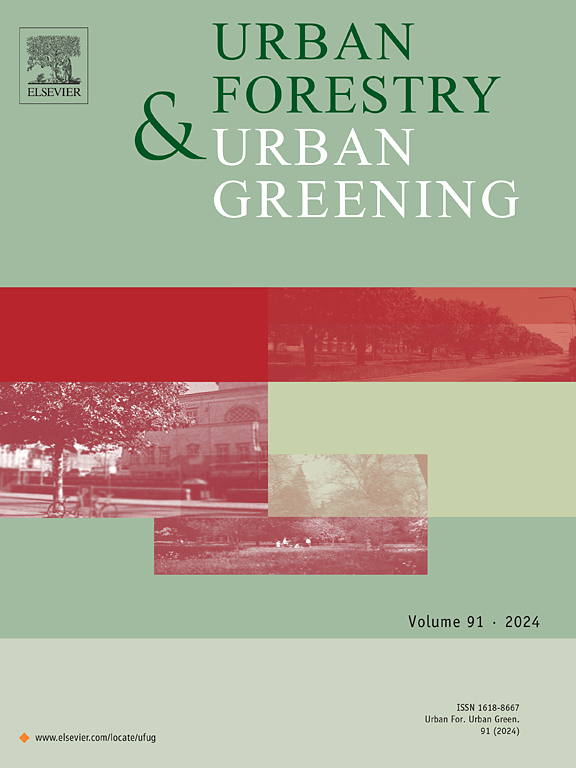基于自然图像的城市行道树树种识别和因子解释模型
IF 6
2区 环境科学与生态学
Q1 ENVIRONMENTAL STUDIES
引用次数: 0
摘要
城市行道树在为人类带来优美生态环境的同时,也可能危害人类健康。树木花粉是一种重要的过敏原,会导致人们患上哮喘和鼻炎,造成严重的医疗负担。为了保护人类健康,降低医疗成本,需要对城市行道树进行准确识别。然而,城市行道树的识别受自然图像(光照强度、季节和拍摄条件的图像)、树木特征和识别模型的影响。为了解决这个问题,我们提出了一种从自然图像中识别树木的解释模型,命名为 Ev2S_SHAP。然后,我们应用该方法解释了环境和树叶因素对树木识别和识别准确率的影响。以不同角度、距离、光线、时间等复杂情况下的城市行道树开源自然图像数据集为研究对象,验证了所提出的树木识别模型。结果表明,50 种树木的识别结果的总体评价:召回率、精确率、准确率和 F1 分数分别为 98.12 %、98.18 %、98.11 % 和 98.13 %。落叶灌木、常绿灌木、落叶乔木和常绿乔木的识别准确率分别为 98.85 %、98.47 %、98.76 % 和 96.38 %。复杂的光线和角度、远距离拍摄和冬季条件削弱了叶片特征的提取,不利于树种的识别。叶形特征对树种鉴定有重要影响。圆度、最小圆周和周长对树种识别的影响分别占 94.36 %、75.61 % 和 69.12 %。圆周率与椭圆叶树种的识别贡献呈正相关,但与披针叶树种的识别贡献相反。周长与披针叶物种的识别呈正相关,但最小周长与披针叶物种的识别呈负相关。Ev2S-SHAP 有效提高了树种鉴定的准确性。该研究为识别和解释树种提供了一种创新方法。本文章由计算机程序翻译,如有差异,请以英文原文为准。
Urban street tree species identification and factor interpretation model based on natural images
Urban street trees bring the beautiful ecological environment for human beings, but also may harm human health. Tree pollen is an important allergen that causes people to suffer from asthma and rhinitis, causing a serious medical burden. In order to protect human health and reduce medical costs, urban street trees need to be accurately identified. However, the identification of the urban street tree is influenced by the natural image (images with light intensity, season and shooting conditions), tree characteristics and identification models. To solve the problem, we proposed an interpretation model for identifying tree from natural images, named Ev2S_SHAP. Then, we applied the method to explain the influence of environmental and leaf factors on tree recognition and the identification accuracy. The open-source natural image dataset of urban street tree with complex situations such as different angles, distances, light, and times was used as the research object to verify the proposed tree identification model. The results showed that the overall evaluation of the identification results for 50 tree species: recall, precision, accuracy, and F1 score were 98.12 %, 98.18 %, 98.11 %, and 98.13 %, respectively. The identification accuracy of deciduous shrubs, evergreen shrubs, deciduous trees, and evergreen trees was 98.85 %, 98.47 %, 98.76 %, and 96.38 %, respectively. Complex lights and angles, long-range shooting, and winter conditions weakened the extraction of leaf features and were not conducive to the identification of tree species. Leaf shape characteristics had important influence on tree species identification. The effects of circularity, minimum circumcircle, and perimeter on tree identification accounted for 94.36 %, 75.61 %, and 69.12 %, respectively. Circularity was positively correlated to the identification contribution of elliptic leaf species, but opposite to that of lanceolate leaf species. The perimeter contributed positively correlated to the identification of lanceolate leaf species, but the minimum circumcircle was negatively. The Ev2S-SHAP effectively improved the identification accuracy of tree species. The study provides an innovative method for identifying and interpreting tree species.
求助全文
通过发布文献求助,成功后即可免费获取论文全文。
去求助
来源期刊

Urban Forestry & Urban Greening
FORESTRY-
CiteScore
11.70
自引率
12.50%
发文量
289
审稿时长
70 days
期刊介绍:
Urban Forestry and Urban Greening is a refereed, international journal aimed at presenting high-quality research with urban and peri-urban woody and non-woody vegetation and its use, planning, design, establishment and management as its main topics. Urban Forestry and Urban Greening concentrates on all tree-dominated (as joint together in the urban forest) as well as other green resources in and around urban areas, such as woodlands, public and private urban parks and gardens, urban nature areas, street tree and square plantations, botanical gardens and cemeteries.
The journal welcomes basic and applied research papers, as well as review papers and short communications. Contributions should focus on one or more of the following aspects:
-Form and functions of urban forests and other vegetation, including aspects of urban ecology.
-Policy-making, planning and design related to urban forests and other vegetation.
-Selection and establishment of tree resources and other vegetation for urban environments.
-Management of urban forests and other vegetation.
Original contributions of a high academic standard are invited from a wide range of disciplines and fields, including forestry, biology, horticulture, arboriculture, landscape ecology, pathology, soil science, hydrology, landscape architecture, landscape planning, urban planning and design, economics, sociology, environmental psychology, public health, and education.
 求助内容:
求助内容: 应助结果提醒方式:
应助结果提醒方式:


